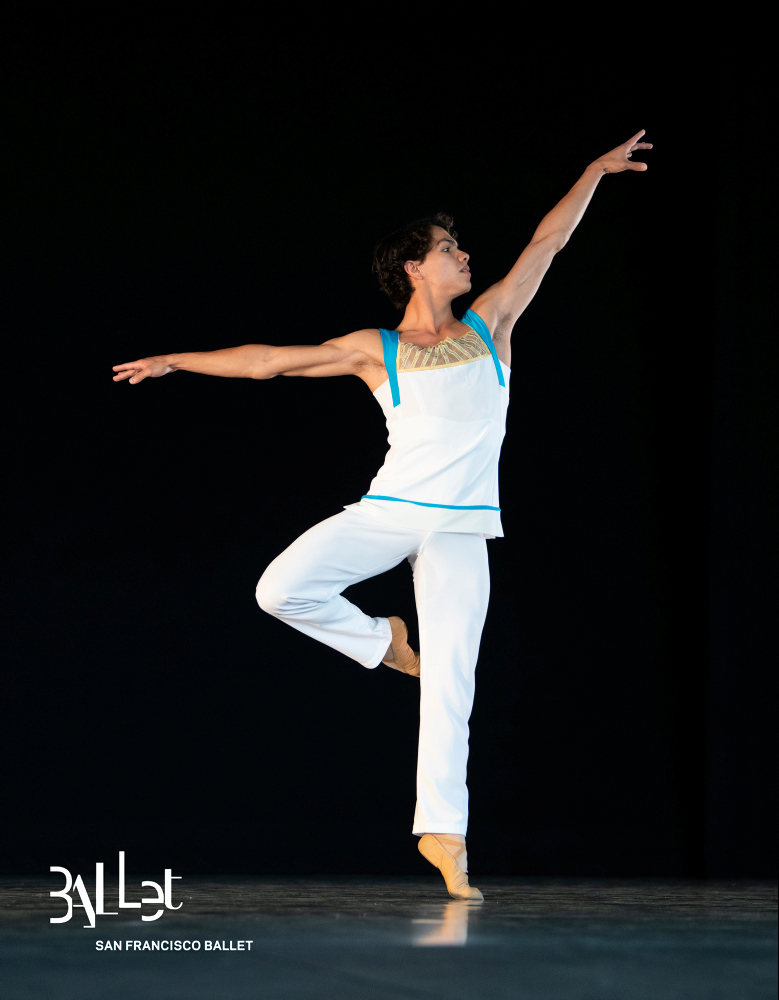George Balanchine’s A Midsummer Night’s Dream will be part of SF Ballet’s 2020 Season, with performances March 6–15, featuring Esteban Hernandez, who was promoted to principal dancer last summer.
Hernandez trained at The Rock School for Dance Education and The Royal Ballet School before joining SF Ballet as a member of the corps de ballet in 2013; he was promoted to soloist in 2017.
A native of Guadalajara, Mexico, Hernandez danced memorable roles in the 2019 Season including the principal solo in the world premiere performance of Scarlett’s Die Toteninsel (a “delicate and muscular, sinuous and doomed” performance, according to SF Chronicle) and his “outstanding, highflying” (SF Classical Voice) Bluebird in The Sleeping Beauty, in addition to principal roles in “. . .two united in a single soul. . .” and Peck’s Rodeo: Four Dance Episodes.
As promised, here is an exclusive interview with this outstanding dancer soon.
Cultural Currents: Since you are performing as both King Oberon, and the mischievous Puck in A Midsummer Night’s Dream, how do you prepare for the shift in roles?
Estaban Hernandez: I try to approach each role individually and try not to get either of the roles influenced by each other. Although they are both magical creatures, their personalities are very different. Since I know all the choreography for both roles, it can sometimes be difficult not to anticipate my actions. I try to be as present as possible and try to forget that I know what’s going to happen and instead, just let it happen. I have found that I can then create a more genuine reaction to my environment that way. It’s been challenging but I’ve had lots of fun as well.
CC: What other unique challenges does a full-length Balanchine work present for you?
Hernandez: Technically speaking, Balanchine’s A Midsummer Night’s Dream is extremely challenging, particularly the role of Oberon. The third scene of the ballet, which we call the scherzo, is some of the fastest, trickiest dancing I’ve had to do so far. Stamina wise, it is also exhausting. During our rehearsal period back in November, I remember finishing that section and not being able to feel my arms. I do have to say that being in command of an army of 30 children, making you feel like you have actual magical powers, makes it worth it.
CC: Can you share your impressions of SF Ballet audiences? Are they generally well prepared for performances?
Hernandez:I think you get a really good mix of everything in the audience! Which I love. You have the devout season ticket holder who’s been coming to the ballet for 20 years and knows all about the dancers and the ballets that are being performed and at the same time you also get a lot of first timers, who are having their first interaction with the ballet. You want them to come back and maybe bring their friend who’s never seen ballet either. I always think about those people, the ones that are experiencing it for the first time… how can I reach them? How can I make them feel something they’ve never felt before?
CC:What are your own thoughts about Shakespeare as a story teller, and Mendelssohn as a composer of this timeless narrative?
Hernandez: I believe Shakespeare, in his time, was not only able to convey some of the most wonderful stories but also set the groundwork for future playwrights and artists to use them as inspiration, or to develop them further. Sometimes the role of an artist is not always to produce for the now. I think it’s most important to produce for the future. So that it can be, so that it doesn’t end with oneself. This is one of the things I think Mendelssohn achieved. He took Shakespeare’s idea and interpreted it using his own set of skills in a way that only he could have done. I am a huge fan of Mendelssohn’s score. I think it puts every musical element that you may need in order to tell the story in the score, at the perfect moment. I could not imagine a better score for A Midsummer Night’s Dream.
CC : Finally, can you describe your routine before taking to the stage? For example, do you visualize or meditate?
Hernandez:I try not to overthink whatever it is I am about to do on stage. I like to prepare myself during the rehearsal process in a way that allows whatever I’m dancing to feel like second nature to me so that when the time comes to be on stage, I don’t have to think about it. Visualization usually helps me most when I am trying to learn choreography or trying to get something to really sink in. My meditation is the warm up barre that I give myself before every show. I do exactly the same routine of exercises that I have been doing since I became a professional dancer. I don’t have to think about elaborate combinations, so I can really focus on how my body is feeling and whatever I might need to pay special attention to.

